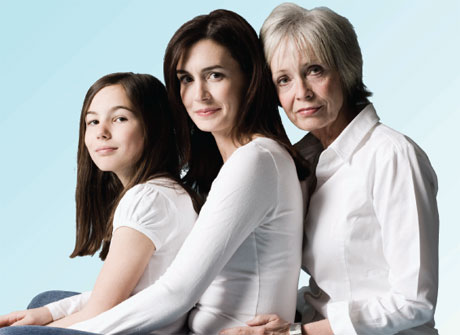 From the weary trenches of early parenthood, it’s easy to view the decades ahead through rose-colored glasses. Someday, the kids will be more independent, weekends won’t be filled with rain-soaked soccer games, and oppressive day-care and school tuition bills will be long gone.
From the weary trenches of early parenthood, it’s easy to view the decades ahead through rose-colored glasses. Someday, the kids will be more independent, weekends won’t be filled with rain-soaked soccer games, and oppressive day-care and school tuition bills will be long gone.
Naturally, this will free up time and funds for a few much-missed leisure pursuits, such as couples’ weekends, golf trips or perhaps just some cherished downtime.
Instead, millions of parents find that the future brings a heavier workload, not a lighter one, as they care for an aging parent (or two) while raising their own brood. This increasingly common scenario can be a burden, or a blessing in disguise, says Carol L. Russell, Ed.D., author of Sandwiched! Tales, Tips, and Tools to Balance Life in the Sandwich Generation.
Often, it’s both burden and blessing, and whether “sandwiched” parents thrive or burn out is a matter of how well they learn to balance an unwieldy bundle of responsibilities.
But it is possible to manage the needs of multiple generations without drowning in neediness, notes Russell. And caregiving and active parenting can happily coexist, even complement one another.
A swelling sandwich
According to the New York Academy of Medicine, some 42 million women between the ages of 35 and 54 make up the “sandwich generation,” tending to growing children and aging parents simultaneously, often during their peak career years. (The AARP reports that three-fourths of family caretakers hold down jobs.)
Adding another slice to the stressful sandwich is the fact that caretaking usually falls to the female partner — even if the parent in need of care is her spouse’s, not hers. According to the AARP and the National Alliance for Caregiving, nearly two out of three adults caring for an older family member or friend are female.
“I’m juggling,” says Issaquah resident Norma Rosenthal, who, with fellow local “sandwich parent” Toby Donner, created the website Girlfriends with Aging Parents as a guide and sounding board for women in the sandwich generation. “That’s the only word for it. I work full time, and I can’t keep those balls in the air fast enough.”
As baby boomers age, the sandwich generation is swelling, while caregivers become more squeezed. According to Georgetown University, the number of people over the age of 65 is expected to increase by 2.3 percent annually, while the number of eligible family caregivers will only increase by .8 percent. By 2015, the U.S. Census Bureau estimates, 19 million Americans will be 85 or older.
But an aging population is not the only factor that’s causing the sandwich to grow. Thanks to a trend toward delayed parenthood (pregnancy rates for women ages 40–44 have been on the rise since 1991), more women find themselves caring for elderly parents while their own children are still firmly in the nest.
Slipping into sandwich mode
Becoming a caregiver to an aging parent usually doesn’t happen overnight. Shuttling a parent to doctor’s appointments and errands gradually morphs into arranging for in-home care, poring over finances and coordinating triage with other family members.
For Russell, a mom of three daughters, caring for her parents started with long-distance care. After two years of arranging round-the-clock help and supervision from hours away, she and her husband opted to move her parents to a newly built home on their property in Kansas.
Whether caregivers tend to aging parents in their own home, from thousands of miles away or in a nursing home, the adjustment to being “on call” 24/7 can be a rough one, says Russell. After their move, Russell took on nighttime caregiving duties for her parents until she realized that she couldn’t care for them at night and fulfill her daytime responsibilities as a professor at Emporia State University in Kansas. She hired nighttime caregivers to reclaim a small slice of balance.
As Russell learned, finding outside support can be an essential aspect of family caregiving. Caregivers are susceptible to burnout, says Seattle-based family therapist Jill Gross, Psy.D. “You have to secure your own oxygen mask before you can help someone else.” That means the caregivers must co-prioritize their own health along with that of their parents, says Gross.
Carving out time for self-care in the midst of the stressful sandwich years isn’t easy, however. Gross recommends that parents find time to do things that gave life meaning before they took on the caregiving role, such as exercise, cooking, art or participating in a faith community. But she acknowledges that continuing those pursuits may not be possible without outside help.
“Caregivers need to have a scheduled time for respite,” Gross says. “Local eldercare resources can help caregivers find people to step in for a few hours so that you can recharge.”
Caregiver support groups are also available, she says. Websites such as Caregiver.com list these groups by area. All of the support groups listed are free to join and attend; some even provide free care for the aging family member(s) during meetings to allow the caretaker to attend.
Family ties
Outside help is a lifeline for caregivers, but finding that support can be a stressor in itself. That’s particularly true when caregivers look to other family members — spouses or siblings — to help provide care and make decisions for aging parents.
Caring for an aging parent can strain even the closest sibling bonds, says Toby Donner. Caretaking often puts one grown sibling in the driver’s seat, with others providing backup support. These vastly different roles spark communication blunders, and resentment can pile up on both sides.
Each grown sibling will approach the issue with a fundamentally different perspective, notes Gross. “The primary caregivers, the people on the front lines who are actually caring for the parent, are seeing and experiencing the world in a different way than the other siblings.”
But finding common ground is possible. Experts agree that effective family meetings can be the cornerstone of positive sibling relationships during the sandwich years. Gross recommends that siblings schedule a meeting face to face or via Skype, free of distractions.
Agree on a start and stop time to the meeting in advance. “It’s better to have short 20- to 30-minute conversations than one that goes on too long,” says Gross. “Siblings have long histories together, and there can be a tendency for things to get heated. You don’t want things to be said that can’t be unsaid.”
Participants should come to the meeting with a short list of goals regarding the care of the aging parent, and begin the session by identifying a primary goal for the meeting: keeping mom safe in her home, for example, or hiring an in-home health-care worker.
“When siblings compare goals, they’ll often find that they’re concerned about the same things,” says Gross. “From there, a natural triage will emerge, and people will naturally come together to a place of openness instead of defensiveness.”
Siblings who can’t get on the same page can find help in the form of family mediation. “Some mediators specialize in this topic,” says Gross. “A neutral third party can be immensely helpful in facilitating a productive meeting.”
Caring with kids
Although juggling parental care and parenting stretches a busy schedule to the limit, caretaking with kids in tow can be a multigenerational boon. Managing both roles simultaneously comes more naturally than many parents assume, says Donner. The skill set used for parenting and the skill set used for caregiving are the same. “You’re parenting your kids and you’re essentially parenting your parents, too,” she notes.
Witnessing and taking part in caretaking helps kids internalize a family’s core values, such as helping others, caring for those in need and giving high priority to our loved ones, says Gross. Children learn that sacrifices must sometimes be made to accommodate loved ones, and that we may have to put aside our own interests to help others, she says. These lessons may get lip service from parents, but nothing drives the point home like seeing parents walk their talk. “Regardless of a child’s age, it says a lot to a child to see a parent caring for an aging parent.”
Whether children are 30 or 10, when you assume care for a parent, they get to see the family values in action, agrees Donner. They learn tolerance and flexibility, and how to handle their own emotions during stressful situations, she says. “In extended caregiving situations, children get to see that they are not the center of the universe all the time.”
Caretaking is often a constant exercise in problem solving — and a way for kids to hone those strategic skills. Worried about grandma falling at home? Need to find a way for grandpa to hear the TV? Kids can help brainstorm and implement solutions for these kinds of concerns.
Teenagers and older children may be able to assist in caregiving duties. Donner’s teenagers drove her parents to doctor’s appointments; Rosenthal’s children passed hours playing cards with their grandparents in the nursing home.
Caretaking has given Rosenthal’s children a deeper, more meaningful bond with their grandparents. “Before, my children were peripherally engaged. Now, my mom is in a walker and can’t bend down, so my daughter helps her garden. Seeing them working together to pot a plant, laughing and sparking memories — that’s really, really special.”
Malia Jacobson is a nationally published freelance writer based in Tacoma. She specializes in health and parenting, and blogs about both at TheWellrestedFamily.com.
FINDING BALANCE
Plan ahead: Is caregiving in your future? Avoid problems down the road with small
steps today.
- Start the conversation: Whether your parent is 55 or 75, asking whether he or she has a health directive or living will is a simple, nonthreatening conversation starter.
- Don’t wait: The cost of allowing a parent to continue driving when he or she is no longer safe behind the wheel is too high to ignore. If a parent clings to the keys, enlist family members or a family counselor for support.
- Heed the ‘Big D's': Plan to review wills and other relevant documents each time a “Big D” rolls around: every decade, when someone dies, gets divorced, has a major diagnosis or a decline in functioning.
Source: Carol L. Russell, Ed.D., author of Sandwiched! Tales, Tips, and Tools to Balance Life in the Sandwich Generation
RESOURCES
Local
Girlfriends with Aging Parents
Geriatric Regional Assessment Team at Evergreen Health
Senior Services, Seattle-King County; 206-448-5757; info@seniorservices.org
Area Agency on Aging for Seattle and King County (ADS); 206-684-0660
Eastside Easy Rider Collaborative; 425-943-6769; info@eastsideeasyrider.org
Mayor’s Office for Senior Citizens; 206-684-0500
National
AARP
National Alliance for Caregiving
Today’s Caregiver
National Resource Center on LGBT Aging
ABC News: The Conversation











